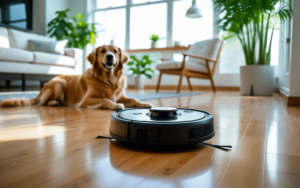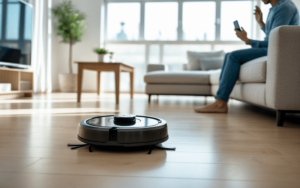Creating a healthy living space starts with the air you breathe.
Indoor air quality often suffers due to allergens, dust, and pollutants, impacting overall wellness. To tackle these issues, some top-rated air purifiers can significantly enhance air quality, providing a breath of fresh air.
Whether it’s allergy relief or general home wellness, investing in an effective air purifier can transform your living environment.
Models like the Dyson Purifier Hot+ Cool Formaldehyde HP09 combine air purification with heating and cooling capabilities, offering versatile solutions for year-round comfort.
Such features cater to diverse needs, making them ideal for those seeking comprehensive indoor air improvement.
Choosing the right air purifier doesn’t just promote a healthier home; it contributes to peace of mind.
For those prioritizing clean air, exploring options like the Coway Airmega 400S Smart Air Purifier ensures that your space remains a sanctuary free from harmful particles.
Discovering the best purifiers will lay the foundation for a healthier, happier home.
Please note that this article contains affiliate links. As an Amazon Associate, we earn from qualifying purchases at no extra cost to you.
Why Air Quality Matters

Understanding the importance of air quality is vital for maintaining a healthy home environment.
Poor air quality can lead to various health issues, while clean air promotes better respiratory health and overall well-being.
Understanding Indoor Air Pollution
Indoor air pollution is often caused by everyday activities and household products.
Common pollutants include dust, pet dander, mold spores, and volatile organic compounds (VOCs) from cleaning supplies or paints.
Poor ventilation can exacerbate these issues, leading to a buildup of harmful substances.
In addition to these contaminants, chemicals and gases from cooking or smoking can contribute to indoor pollution.
It is crucial to identify and minimize these sources to maintain a clean indoor environment.
Installing air purifiers and ensuring proper ventilation can significantly reduce these pollutants.
Health Benefits of Clean Air
Breathing clean air at home is linked to numerous health benefits.
Improved air quality reduces allergy symptoms and the risk of respiratory issues such as asthma.
It can also enhance sleep quality and boost overall energy levels by providing the body with cleaner oxygen.
Cleaner air has positive impacts on cognitive function and concentration, making it especially important in homes with children or for those working from home.
By using devices like air purifiers and maintaining good ventilation, households can enjoy these health benefits and contribute to a better quality of life for everyone.
Choosing the Right Air Purifier

To find the best air purifier for your home, it’s essential to understand the different types, key features, and how to choose the right size and placement.
These factors will ensure the air purifier effectively improves your indoor air quality.
Types of Air Purifiers
Air purifiers come in several varieties, each with distinct technologies and benefits.
HEPA filters are popular for capturing 99.97% of airborne particles like dust and pollen. They are exceptional for allergy sufferers.
Activated carbon filters are effective against odors and smoke, making them ideal for kitchens or areas with cigarette smoke.
Another type is UV-C light purifiers, which kill bacteria and viruses. This option is beneficial for reducing pathogens in homes.
Ionic purifiers release charged ions that clump particles together, which are then caught on surfaces or filters.
Each type has specific strengths, so evaluating personal needs will guide the choice.
Key Features to Look For
When selecting an air purifier, a few critical features should be considered.
CADR (Clean Air Delivery Rate) is essential as it measures the purifier’s efficiency in cleaning smoke, pollen, and dust. The higher the CADR, the faster the air is cleaned.
Noise levels are also important; look for models with a low decibel rating for quiet operation, especially in bedrooms.
Energy efficiency can impact electricity bills, so ENERGY STAR-rated models are preferable.
Some purifiers offer smart features, such as connectivity with smartphones for remote control, which adds convenience.
Filter replacement indicators help in maintaining optimum efficiency by reminding when to change filters, keeping the air fresh and clean.
Size and Placement Considerations
Selecting the right size of an air purifier depends on the room it will serve.
Measure the room’s square footage and choose a purifier designed to cover that area. Larger units may be necessary for open-concept spaces, while smaller rooms can benefit from compact models.
Placement plays a vital role in maximizing effectiveness.
Position the air purifier centrally, away from walls, for better airflow. Avoid corners as they restrict air circulation.
If possible, elevate the unit off the floor to improve reach.
Proper size and strategic placement ensure comprehensive air cleaning, helping maintain cleaner indoor air.
Best Air Purifiers on the Market
Searching for the best air purifier depends on specific needs, but key types like HEPA, activated carbon, UV light, and ionic air purifiers offer distinct advantages. Understanding these types helps in choosing one that fits a person’s lifestyle and needs, whether it’s removing allergens, odors, or germs.
HEPA Filters
HEPA filters are a favorite for those who suffer from allergies and asthma.
They efficiently trap fine particles like pollen, pet dander, and dust. These filters are rated to capture particles as small as 0.3 microns with a 99.97% efficiency.
https://amzn.to/4gqTEUzModels such as the Coway AP-1512HH perform exceptionally in this category. It features a four-stage filtration process, ensuring clean air. Users seeking to maintain a healthy environment stand to gain from using purifiers with HEPA technology.
Activated Carbon Filters
Activated carbon filters are ideal for removing odors, gases, and volatile organic compounds (VOCs).
They work by absorbing these contaminants, making them a great choice for homes where cooking smells or smoke is common.
The Winix 5500-2 is a notable example, combining an advanced carbon filter with HEPA filtration for added effectiveness. When battling strong odors or pollutants from urban living, activated carbon filters are essential.
UV Light Purifiers
UV light purifiers are effective against microorganisms such as bacteria and viruses.
They use ultraviolet light to break down these harmful pathogens, providing an extra layer of protection to indoor air quality.
For households focused on disinfecting their space, models like the GermGuahttps://www.excitel.com/blogs/benefits-of-dual-band-routers-for-seamless-connectivity/rdian AC4825 offer a compact and functional design. This device combines UV-C light with HEPA filtration, making it efficient at sanitizing indoor air without chemical use.
Ionic Air Purifiers
Ionic air purifiers release charged ions into the air, which attach to particles, causing them to settle out of the airspace.
These purifiers are quieter since they don’t rely on fans, making them suitable for a peaceful home setting.
A popular choice is the AirTamer A310, known for its portability and efficiency in reducing airborne particles. While they are quieter and energy-efficient, users should note they might produce ozone, which could be a concern for sensitive individuals.
We may earn a small commission if you purchase through this link. Thank you for supporting our content!
Maintaining Your Air Purifier

Caring for your air purifier involves regular cleaning and timely filter replacements. This not only ensures its efficiency but also extends the device’s lifespan, providing cleaner air in your home for longer periods.
Regular Cleaning and Care
Keeping an air purifier clean is vital for its optimal performance. Dust and debris can accumulate on the exterior and internal components, leading to reduced efficiency.
Users should wipe the exterior surfaces with a soft, damp cloth to remove dust. Cleaning the vents with a vacuum or soft brush is also recommended.
Make sure to consult the manual for specific cleaning instructions, as some parts may require careful handling.
For those with washable parts, such as pre-filters, rinsing them under running water and allowing them to dry thoroughly before reassembly is crucial.
Regular cleaning schedules can vary, but doing these tasks once a month helps maintain the device’s efficacy.
Filter Replacement and Costs
Filters are the heart of any air purifier, trapping pollutants like pollen, dust, and smoke particles.
It’s essential to replace filters as recommended by the manufacturer to ensure optimal air quality.
For most models, filter replacement ranges from every 3 to 12 months, depending on usage and air quality conditions.
Some filters are more cost-effective in the long run. HEPA filters, while typically more expensive, tend to last longer and are more effective, making them a good investment.
Familiarizing oneself with the type and cost of filters before purchasing an air purifier aids in understanding long-term maintenance expenses.
Users can find more details about filter replacement from guides like this maintenance guide.
Enhancing Home Air Quality Beyond Purification

Improving air quality at home involves more than just purifiers.
Natural ventilation and houseplants are effective ways to maintain fresh and clean air indoors. These methods are both eco-friendly and cost-effective, providing a holistic approach to a healthier home environment.
Natural Ventilation
Natural ventilation is an easy and efficient way to let fresh air circulate throughout the home.
By simply opening windows and doors, homeowners can reduce the buildup of indoor pollutants. This practice is especially beneficial during mild weather when fresh, outdoor air can replace stale indoor air.
Cross-ventilation enhances this process by opening windows or doors on opposite sides of a room or building. This method creates a flow of air that helps flush out contaminants and regulate indoor temperature.
Ceiling fans and window fans can enhance airflow and aid in this natural exchange of air.
In urban settings, where outdoor air quality may be a concern, it might be best to ventilate during early mornings or late evenings when pollution levels tend to be lower.
Houseplants for Air Quality
Houseplants not only beautify a home but can also contribute to better air quality.
Some plants, like the peace lily, snake plant, and spider plant, are known to filter airborne toxins such as formaldehyde and benzene.
These plants are hardy and require minimal care, making them ideal for households with busy lifestyles.
Incorporating various plants throughout different rooms can create a natural filter.
Strategically placing them in areas with less ventilation can be especially effective.
It’s important to consider lighting and watering needs to ensure plants thrive and provide the best air-cleaning benefits.
These green companions offer a simple, natural solution to enhance indoor environments, contributing to both oxygen production and aesthetic appeal.
This article contains affiliate links, which means we may earn a commission if you purchase through our links, at no extra cost to you. As an Amazon Associate, we earn from qualifying purchases. Thank you for supporting our content!




